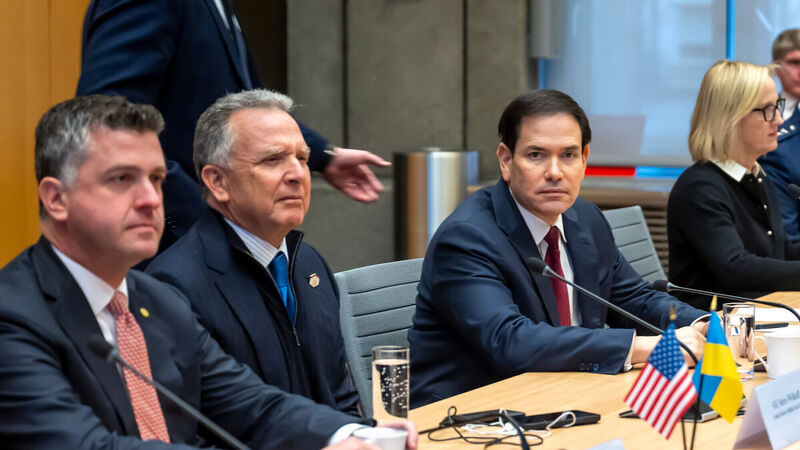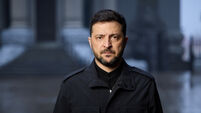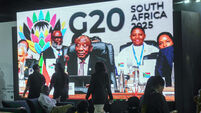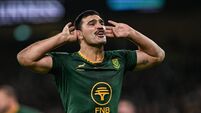US and Ukraine report progress on ending Russia war but offer few details

Top US and Ukrainian officials said they were making progress towards ending the Russia-Ukraine war but provided scant details as they discussed the American proposal to achieve peace despite concerns among many of Washington’s European allies that the plan was far too conciliatory to Moscow.
US secretary of state Marco Rubio said high-stakes talks in Geneva were “very worthwhile” and constituted the most productive day in “a very long time” on larger efforts to end the fighting.
“I feel very optimistic that we can get something done,” Mr Rubio said.

But he offered very little information on what was discussed, allowing only that discussions would continue on Monday and perhaps deeper into the week.
He also suggested that Europe’s role and responsibilities as spelled out under the US peace plan might be separated from facets more directly involving the responsibilities of Russia and Ukraine.
And Mr Rubio noted that any final product, once it is ready, will still have to be presented to Moscow: “Obviously, the Russians get a vote here.”
Mr Rubio’s attempt to strike such a positive tone while offering no evidence of a breakthrough constituted a more nuanced approach than US President Donald Trump himself.
Before talks even really began, the president blasted Ukraine for a lack of gratitude for US military assistance, while shying away from criticising Russia.
Mr Trump has set a Thursday deadline for Ukraine to respond to the plan.
But he also has suggested that could slide if there was proof of real progress and that the plan was not his final offer.
Mr Rubio also undermined the idea that the deadline was looming, saying simply that officials want to see fighting stop as soon as possible.
Some American and European supporters of Ukraine have panned the plan as too favourable to Moscow.
Questions intensified after a bipartisan group of US senators said Mr Rubio told them on Saturday that the plan had originated with Russia and was actually a “wish list” for Moscow, rather than a serious push for peace.

The head of the Ukrainian delegation, presidential chief of staff Andrii Yermak, also confirmed an initial session of talks had concluded and that a second meeting would soon take place.
“I want to confirm that we had a very productive first session with the distinguished American delegation. We have made very good progress and are moving forward to a just and lasting peace,” he said.
“Very soon today the second meeting will take place, where we will continue to work on joint proposals with the engagement of our European partners. Final decisions will be taken by our presidents.”
Before the meeting even began, however, Mr Trump suggested he did not expect much.
He posted on his social media site that: “UKRAINE ‘LEADERSHIP’ HAS EXPRESSED ZERO GRATITUDE FOR OUR EFFORTS, AND EUROPE CONTINUES TO BUY OIL FROM RUSSIA.”
After Mr Trump’s post, Ukrainian President Volodymyr Zelensky cheered US-led efforts on security while also stressing that “the crux of the entire diplomatic situation is that it was Russia, and only Russia, that started this war”.
“Ukraine is grateful to the United States, to every American heart, and personally to President Trump,” Mr Zelensky wrote in a post on Telegram, adding: “We thank everyone in Europe.”
“It is important not to forget the main goal – to stop Russia’s war and prevent it from ever igniting again.”
– Ukraine and allies have ruled out territorial concessions
The 28-point blueprint drawn up by the US to end the nearly four-year war has sparked alarm in Kyiv and European capitals.
Mr Zelensky has said his country could face a stark choice between standing up for its sovereign rights and preserving the American support it needs.

The proposal, originating from negotiations between Washington and Moscow, acquiesces to many Russian demands that Mr Zelensky has categorically rejected on dozens of occasions, including giving up large pieces of territory.
The Ukrainian leader has vowed that his people “will always defend” their home.
Before convening with US officials, Mr Yermak and his team also met with national security advisers from the UK, France and Germany.
The allies have rallied around Kyiv in a push to revise the plan, which is seen as favouring Moscow.
On Sunday, Mr Zelensky said that there was an understanding the US would take into account “a number of elements” in a peace deal that are important for Ukraine, but did not elaborate further.
“There have already been brief reports from the team about the results of the first meetings and conversations,” he said.
“There is now an understanding that the American proposals may take into account a number of elements based on the Ukrainian vision and are critically important for Ukraine’s national interests.”
Mr Trump has not clarified his comment on Saturday that the US proposal was not his final offer.
“I would like to get to peace. It should have happened a long time ago. The Ukraine war with Russia should have never happened,” Mr Trump told reporters outside the White House on Saturday.

“One way or the other, we have to get it ended.”
– Rubio’s reported comments cause confusion
Polish Prime Minister Donald Tusk said on Sunday that Warsaw was ready to work on the plan with the leaders of Europe, Canada and Japan, but also said that it “would be good to know for sure who is the author of the plan and where was it created”.
Some US lawmakers said on Saturday that Mr Rubio had described the plan as a Russian “wish list” rather than a Washington-led proposal.
A US State Department spokesperson said that account was “blatantly false”.
Mr Rubio took the extraordinary step of suggesting online that the senators were mistaken, even though they said he was their source for the information.
The top Democrat on the US Senate Intelligence Committee, senator Mark Warner told ABC’s “This Week” on Sunday that the peace plan appeared to be “almost a series of Russian talking points”, had made Europeans “feel like they’ve been totally left high and dry” and had led to “ferocious pushback”.
– Possibility for additional talks
Turkish President Recep Tayyip Erdogan announced that he would hold a phone call with Russian President Vladimir Putin on Monday.
He said he would talk to the Russian leader about reviving a previous deal from July 2022 that allowed Ukraine to safely ship exports of grain via the Black Sea.
The agreement stayed in place until the following year, when Mr Putin refused to extend it, saying that a parallel agreement promising to remove obstacles to Russian exports of food and fertiliser had not been honoured.
“We had a grain corridor endeavour to open the path to peace,” Mr Erdogan said.
“Unfortunately we were only partially able to succeed. Tomorrow I will be asking Putin to revisit the endeavour.”
Mr Erdogan’s new diplomatic push comes just days after he met with Mr Zelensky in Ankara.











